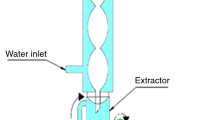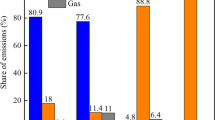Abstract
The NO oxidation performance in a non-thermal plasma (NTP) reactor under realistic synthetic exhaust gas compositions is investigated. The gas compositions differ mainly in the NO–NO2 ratio and represent different modes of operation of a marine diesel engine. It is found that the maximum NO oxidation efficiency is independent on the NO–NO2 ratio. Up to 55 % of the NO is mainly oxidised to NO2 in all gas mixtures being analysed. However, the specific energy density needed to reach the highest NO oxidation varies with the gas composition between 15 and 60 J/L. The performance of the NTP-reactor was significantly improved by the addition of propene (C3H6) acting as an additional oxidising agent. The energy consumption for NO–NO2 conversion was found to be between 20 and 45 eV/NO, depending on the ratio of the added propene as well as the initial concentrations of nitrogen oxides.








Similar content being viewed by others
References
Designation of North American emission control area to reduce emissions form ships (2010) U.S. Environmental Protection Agency, Ann Arbor. http://www.epa.gov/otaq/regs/nonroad/marine/ci/420f11024.pdf. Accessed 27 Okt 2011
Special Areas under MARPOL (2012) International Maritime Organization, London. http://www.imo.org/OurWork/Environment/PollutionPrevention/SpecialAreasUnderMARPOL/Pages/Default.aspx. Accessed 08 Febr 2012
Differentiated port and fairway dues (2011) Clean North Sea shipping, Newcastle. http://cleantech.cnss.no/policies-and-instruments/voluntary-instruments/clean-shipping-index/. Accessed 11 April 2012
Skalska K, Miller J, Ledakowicz S (2010) Trends in NOx abatement: a review. Sci Total Environ 408:3976–3989
Dinelli G, Civitano L, Rea M (1990) Industrial experiments on pulse corona simultaneous removal of NOx and SO2 from flue gas. IEEE Trans Ind Appl 26:535–541
Penetrante BM, Hsiao MC, Merritt BT, Vogtlin GE (1997) Fundamental Limits on NOx Reduction by Plasma. SAE Technical Paper 971715. Doi:10.4271/971715
Hoard J, Laing P, Balmer ML, Tonkyn R (2000) Comparison of plasma-catalyst and active lean-NOx catalyst. SAE Tech Paper 2000-01-2895. doi:10.4271/2000-01-2895
Trompeter F-J (2001) Barrierenentladungen zum Abbau von Schadstoffen in motorischen Verbrennungsabgasen. Ph.D Dissertation. Rheinisch-Westfälische Technische Hochschule Aachen, Aachen
Hammer T (2002) Non-thermal plasma application to the abatement of noxious emissions in automotive exhaust gases. Plasma Sources Sci Technol 11:196–201
Chae JO (2003) Non-thermal plasma for diesel exhaust treatment. J Electrostat 57:251–262
McAdams R, Beech P, Gillespie R, Guy C, Jones S, Liddel T, Morgan R, Shawcross J, Weeks D, Hughes D, Oesterle J (2003) Non-thermal plasma based technologies for the aftertreatment of automotive exhaust particulates and marine diesel exhaust NOx. Paper presented at the Diesel engine emission reduction conference, Newport, Rhode Island
Mok YS, Ravi V, Kang HC, Rajanikanth BS (2003) Abatement of nitrogen oxides in a catalytic reactor enhanced by nonthermal plasma discharge. IEEE Trans Plasma Sci 31:157–165
Zrilli T (2005) Plasma und plasmakatalytische Verfahren zum NOx-Abbau im Dieselabgas. Ph-D dissertation. Universität Fridericiana zu Karlsruhe, Karlsruhe
Okubo M, Kuroki T, Kitaura K, Yamamoto T (2006) Diesel engine emission control using pulsed corona plasma-wet chemical hybrid process. J Environ Eng 1:29–38
Müller S, Zahn R-J (2007) Air pollution control by non-thermal plasma. Contrib Plasm Phys 47:520–529
Van Durme J, Dewulf J, Leys C, Van Langenhove H (2008) Combining non-thermal plasma with heterogeneous catalysis in waste gas treatment: a review. Appl Catal B Environ 78:324–333
Hołub M, Kalisiak S, Borkowski T, Myśków J, Brandenburg R (2010) The influence of direct non-thermal plasma treatment on particulate matter (PM) and NOx in the exhaust of marine diesel engines. Pol J Environ Stud 19:1199–1211
Guan B, Lin H, Cheng Q, Huang Z (2011) Removal of NOx with selective catalytic reduction based on nonthermal plasma preoxidation. Ind Eng Chem Res 50:5401–5413
Fresnet F, Baravian G, Magne L, Pasquiers S, Postel C, Puech V, Rousseau A (2000) Kinetic of the NO removal by nonthermal plasma in N2/NO/C2H4 mixtures. Appl Phys Lett 77:4118–4120
Penetrante BM, Hsiao MC, Merritt BT, Vogtlin GE, Wallman PH, Neiger M, Wolf O, Hammer T, Broer S (1996) Pulsed corona and dielectric-barrier discharge processing of NO in N2. Appl Phys Lett 68:3719–3721
Brandenburg R, Maiorov VA, Golubovskii YB, Wagner H-E, Behnke J, Behnke JF (2005) Diffuse barrier discharges in nitrogen with small admixtures of oxygen: discharge mechanism and transition to the filamentary regime. J Phys D Appl Phys 38:2187–2197
Kogelschatz U (2003) Dielectric-barrier discharges: their history, discharge physics, and industrial applications. Plasma Chem Plasma Process 23:1–46
Dorai R, Kushner MJ (2000) Consequences of propene and propane on plasma remediation of NOx. J Appl Phys 88:3739–3747
Penetrante BM, Brusasco RM, Merritt BT, Vogtlin GE (1999) Environmental applications of low-temperature plasmas. Pure Appl Chem 7:1829–1835
Lin H, Guan B, Cheng Q, Huang Z (2010) An investigation on the principal paths to plasma oxidation of propylene and NO. Energy Fuels 24:5418–5425
Dilecce G, Ambrico PF, De Benedictis S (2007) N2 (A3Σ +u ) density measurement in a dielectric barrier discharge in N2 and N2 with small O2 admixtures. Plasma Sources Sci Technol 16:511–522
Acknowledgments
This work was supported by the Federal Ministry of Economics and Technology: Joint research project ERA-NET MARTEC PBCT, project funding reference number 03SX288A. The authors like to thank the Marine University Szczecin for providing the exhaust composition data. Special thanks go to Wolfgang Reich and Bernd Nehmzow (both INP Greifswald)) for their technical support and assistance and Robin Summerer (neoplas GmbH) for fruitful cooperation.
Author information
Authors and Affiliations
Corresponding author
Rights and permissions
About this article
Cite this article
Schmidt, M., Basner, R. & Brandenburg, R. Hydrocarbon Assisted NO Oxidation with Non-thermal Plasma in Simulated Marine Diesel Exhaust Gases. Plasma Chem Plasma Process 33, 323–335 (2013). https://doi.org/10.1007/s11090-012-9424-6
Received:
Accepted:
Published:
Issue Date:
DOI: https://doi.org/10.1007/s11090-012-9424-6




